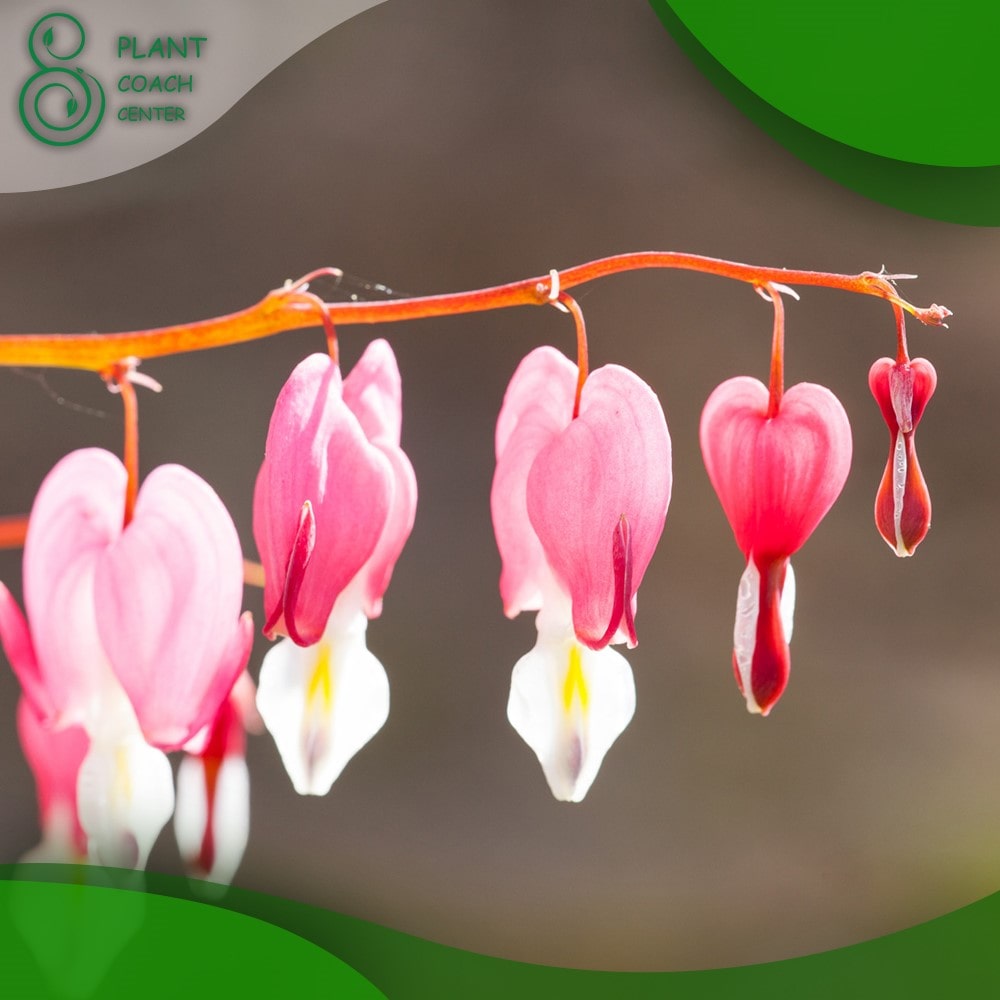Bleeding Heart (Dicentra spectabilis) is a captivating perennial plant known for its heartshaped blossoms that dangle gracefully like delicate jewels from arching stems. Native to Asia and North America, this charming plant has won the hearts of gardeners worldwide with its romantic allure and enchanting presence in the spring garden.
The Charm of Bleeding Heart Plants
Bleeding Heart’s unique floral display, with its elegant pink, white, or red flowers, has captivated gardeners for generations. Its whimsical appearance and poetic name evoke a sense of tenderness and emotion, making it a cherished addition to any landscape. The gracefully arching stems, fernlike foliage, and fascinating flower structure all contribute to its popularity in traditional and contemporary garden designs.
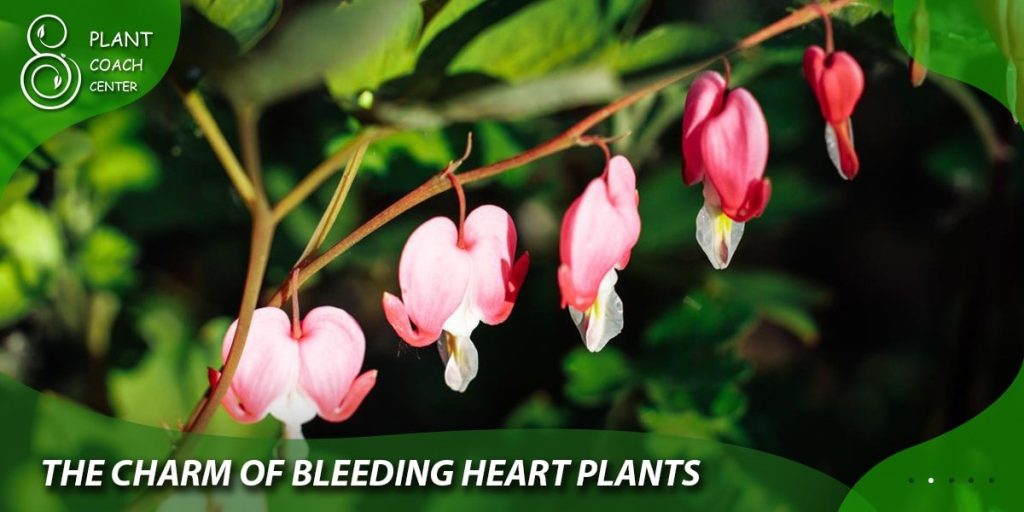
Cultivating Bleeding Heart: A Plant Lover’s Delight
Cultivating Bleeding Heart brings joy to the hearts of plant enthusiasts. The plant prefers partial shade to thrive, though it can tolerate full sun in cooler climates. When selecting a planting site, keep in mind that welldraining, moist soil rich in organic matter will enhance its growth. In colder regions, mulching can help protect the plant during harsh winters.
Understanding Bleeding Heart Growth Cycles
To provide the best care for Bleeding Heart, it’s essential to understand its growth cycles throughout the year.
Spring Emergence: New Beginnings
As winter retreats, Bleeding Heart awakens from dormancy, and its buds begin to break through the soil’s surface. In the early days of spring, you can witness the emergence of its distinctive foliage, resembling the fresh growth of ferns. This is an exciting moment for gardeners, as it marks the start of a new growing season.
Summer Bloom: Splashes of Color
Late spring and early summer herald the arrival of Bleeding Heart’s enchanting flowers. The heartshaped petals, known as “corollas,” open like locket pendants, revealing the inner beauty of the blooms. During this period, the plant becomes a beacon of color and attracts pollinators such as bees and butterflies, contributing to the ecosystem’s health.
Fall and Winter: Rest and Retreat
As the summer wanes, Bleeding Heart’s flowers gradually fade, and the plant begins its transition into dormancy. While the aboveground foliage withers away, the underground rhizomes conserve energy for the following spring. This dormant period is crucial for the plant’s survival, and proper care during this time sets the stage for robust growth in the next season.
Observing Your Bleeding Heart
To ensure your Bleeding Heart remains healthy, regularly observe the plant for signs of its overall condition and potential issues.
Recognizing Varieties of Bleeding Heart
The Bleeding Heart genus encompasses various species and cultivars, each exhibiting unique characteristics. The most common species, Dicentra spectabilis, features pink or white heartshaped flowers. Other notable varieties include the golden leafed Dicentra spectabilis ‘Gold Heart’ and the fringed petals of Dicentra eximia ‘Luxuriant.’ Familiarizing yourself with these differences will assist in understanding their specific care requirements.
Evaluating Plant Health
A thriving Bleeding Heart exhibits vigorous growth, lush foliage, and abundant blooms. Regularly inspect the leaves, stems, and flowers for any signs of distress, including discoloration, wilting, or pest infestations. Early detection of problems allows for prompt intervention, which is essential for preventing severe damage.
Identifying Common Plant Problems
Bleeding Heart, like any plant, may face certain challenges. Common problems include fungal diseases like powdery mildew or leaf spots, as well as attacks from pests like slugs and snails. By knowing the signs of these issues, you can take appropriate measures to address them effectively.
The Importance of Proper Pruning
Pruning is a vital aspect of Bleeding Heart care, contributing to the plant’s overall health, shape, and blooming performance.
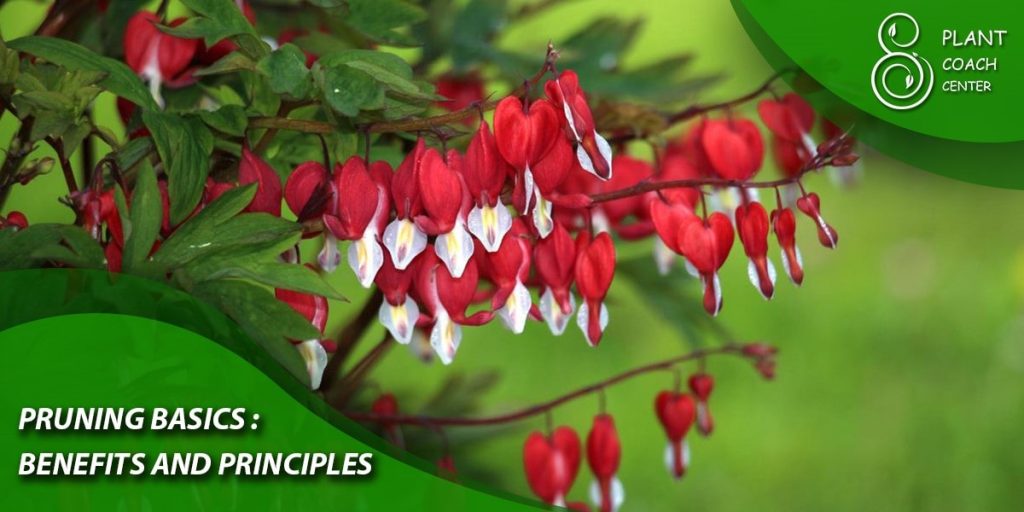
Pruning Basics: Benefits and Principles
Proper pruning enhances the plant’s appearance by maintaining a compact and attractive shape. It also encourages the production of new growth and flowers. Regular pruning helps remove dead or diseased parts, improving air circulation and reducing the risk of fungal infections. By following pruning principles, such as using sharp and clean tools, you can make precise cuts that promote healthy regrowth.
Tools for Pruning Bleeding Heart
For effective pruning, equip yourself with the right tools. Secateurs or pruning shears are essential for precision cuts, while loppers may be necessary for thicker stems. Ensure that your tools are sharp and sanitized before use to prevent the spread of diseases.
Timing Matters: Best Times to Prune
The timing of pruning significantly impacts Bleeding Heart’s growth and flowering. Generally, pruning is best performed after the plant enters its dormant stage in late fall or early winter. This allows the plant to focus on root development and conserve energy during the colder months. However, deadheading spent blooms during the blooming season can prolong flowering and encourage the growth of new buds.
When to Cut Back Bleeding Heart
Knowing the appropriate time to cut back on your Bleeding Heart is crucial for its overall health and performance.
Signs It’s Time to Cut Back
Observe your Bleeding Heart for indications that it requires cutting back. Signs such as excessive wilting, overgrown or tangled stems, or discolored and damaged foliage may indicate the need for pruning. Additionally, cutting back after the flowering season helps maintain the plant’s vigor and aesthetics.
Understanding Plant Signals
Bleeding Heart communicates its needs through various visual cues. It’s essential to interpret these signals to provide the appropriate care. For example, drooping foliage may indicate dehydration, while yellowing leaves may suggest nutrient deficiencies. By understanding these signs, you can address the plant’s needs promptly.
Deciding the Right Cutback Time
The best time to cut back Bleeding Heart depends on its growth stage and local climate. In colder regions, cutting back after the first frost signals the plant’s entry into dormancy. In milder climates, where the plant may retain some foliage during winter, it’s best to wait until late winter or early spring for pruning.
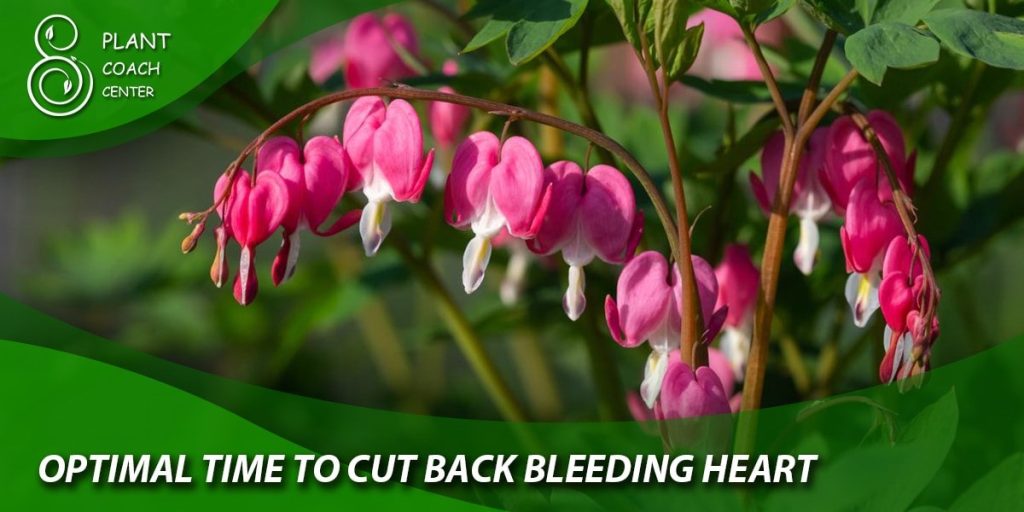
StepbyStep Guide to Cutting Back Bleeding Heart
Properly cutting back Bleeding Heart requires a systematic approach to achieve the desired results.
Preparing for Pruning
Before you begin pruning, assess the plant’s overall condition and gather the necessary tools. Choose a dry day to avoid potential damage to the plant or the spread of diseases.
Pruning Techniques: Dos and Don’ts
When pruning, make clean cuts just above a leaf node or bud to promote new growth. Avoid cutting back more than onethird of the plant’s total foliage, as excessive pruning can stress the plant. Also, refrain from pruning during the active growing season to avoid disrupting the flowering process.
PostPruning Care
After pruning, provide proper postcare to facilitate the plant’s recovery and growth. Water the Bleeding Heart adequately and apply a layer of organic mulch around the base to conserve moisture and suppress weed growth.
Addressing Specific Plant Problems
Dealing with Overgrown Bleeding Heart
Over time, Bleeding Heart may become overgrown and lose its tidy appearance. To tackle this issue, rejuvenation pruning can be employed. Rejuvenation involves cutting back the plant significantly to stimulate new growth from the base. Carefully assess the plant’s health before undertaking rejuvenation pruning, as older or weaker specimens may struggle to recover.
Managing Pests and Diseases
Pests and diseases can pose a threat to Bleeding Heart’s wellbeing, affecting its growth and blooming. Implementing integrated pest management (IPM) strategies is essential for effectively dealing with these issues. Encouraging natural predators, using biological controls, and employing organic remedies can help manage pests without harming beneficial insects.
Correcting Soil and Environmental Issues
The health of a Bleeding Heart is profoundly influenced by its growing conditions. Poor soil quality, improper drainage, or unsuitable light exposure can lead to various problems. Conduct soil tests to identify nutrient deficiencies and amend the soil accordingly. Additionally, ensure adequate drainage to prevent waterlogged roots and adjust the plant’s location to provide the right amount of sunlight.
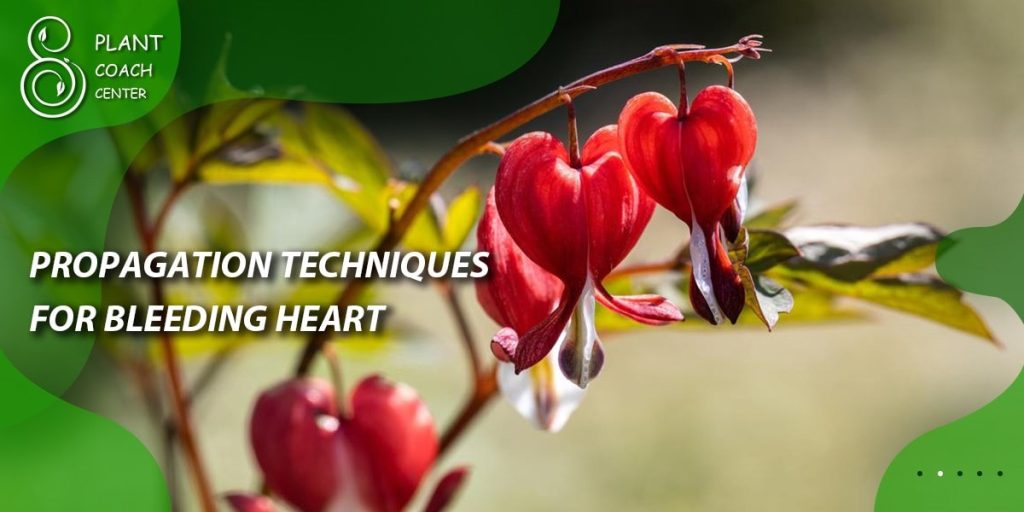
Propagation Techniques for Bleeding Heart
Understanding Reproduction Methods
Bleeding Hearts can be propagated through different methods, including seeds and vegetative propagation.
Propagating Bleeding Heart: Seeds vs. Cuttings
Growing Bleeding Heart from seeds can be a rewarding experience, but it requires patience and care. Alternatively, propagating from stem cuttings offers a quicker method to produce new plants with identical traits as the parent.
Caring for Bleeding Heart in Different Climates
Adaptations for Warm Climates
In regions with hot summers, providing adequate shade and regular watering is crucial for Bleeding Heart’s survival. Mulching around the plant can help retain soil moisture and regulate temperature.
Nurturing Bleeding Heart in Cold Regions
In colder climates, protecting Bleeding Heart during the winter months is essential. Applying a thick layer of mulch over the rhizomes can insulate the plant and shield it from frost.
Indoor Care for Potted Bleeding Heart
Growing Bleeding Heart in containers allows for more control over its growing conditions. Ensure the pot has proper drainage, and consider moving the plant indoors during extreme weather conditions.
Companion Planting with Bleeding Heart
Choosing Suitable Companions
Selecting suitable companion plants can enhance the beauty of Bleeding Heart and create a harmonious garden setting. Shadeloving plants like ferns, hostas, and astilbes make excellent companions for Bleeding Heart.
Creating Harmonious Plant Combinations
Consider the color, texture, and height of companion plants to create visually appealing combinations. Grouping plants with similar water and light requirements will also facilitate their care.
Bleeding Heart in Landscaping and Gardens
Designing with Bleeding Heart
In landscape design, Bleeding Heart can be used as a focal point or a striking element in a mixed perennial border. Its unique form and vibrant flowers add interest to any garden setting.
Bleeding Heart as a Focal Point
To create a captivating garden display, use Bleeding Heart as a focal point. Plant it in a prominent location where its graceful arching stems and heartshaped blooms can draw attention. Surround it with complementary plants that accentuate its beauty without overpowering it.
Combining Bleeding Heart with Other Flowers
Bleeding Heart blends harmoniously with various flowering plants, contributing to a tapestry of colors and textures. Pair it with springflowering bulbs like tulips and daffodils for a stunning earlyseason display. The delicate blooms of bleeding hearts also complement the bold, showy flowers of peonies, creating a captivating contrast.
Myths and Misconceptions About Cutting Back Bleeding Heart
Debunking Common Misbeliefs
There are several myths surrounding the pruning and care of Bleeding Heart that can misguide gardeners. One common misconception is that cutting back the plant too early in the growing season will result in poor flowering. In truth, proper timing and technique can promote healthy growth and abundant blooms.
Separate Facts from Fiction
By dispelling myths and misconceptions, gardeners can confidently care for Bleeding Heart and appreciate its true potential. Rely on reputable sources and horticultural experts to get accurate information about plant care.
Preserving Bleeding Heart: Conservation Efforts
Threats to Bleeding Heart Species
Some species of Bleeding Heart face challenges due to habitat loss, climate change, and invasive species. Understanding the conservation status of various Bleeding Heart species is essential for conservation efforts.
Conservation Organizations and Initiatives
Numerous organizations work towards the conservation of native plant species, including Bleeding Heart. Supporting these initiatives helps protect the plant’s natural habitat and ensures its survival for future generations.
Conclusion
Cultivating and pruning Bleeding Heart is a rewarding endeavor that allows gardeners to experience the enchanting beauty of this delicate plant. By understanding its growth cycles, observing its needs, and employing proper pruning techniques, gardeners can ensure healthy growth and stunning displays of heartshaped blossoms year after year.
Embracing the Beauty of Nature’s Marvel: Bleeding Heart
Bleeding Heart holds a special place in the hearts of plant lovers around the world. Its elegance and allure inspire awe and admiration, reminding us of the delicate beauty of nature. Whether used as a focal point or combined with other flowering plants, Bleeding Heart brings an ethereal charm to gardens and landscapes, creating moments of magic that resonate with both gardeners and visitors alike.
As we continue to care for this extraordinary plant, let us also appreciate the importance of conservation efforts to safeguard its existence for generations to come. In doing so, we honor the legacy of Bleeding Heart and its enduring contribution to the world of horticulture.
When is the best time to prune a Bleeding Heart?
Late fall or early winter.
Can a Bleeding Heart grow in full sun?
It prefers partial shade but can tolerate full sun in cooler climates.
How do I propagate Bleeding Heart?
It can be propagated from seeds or stem cuttings.


